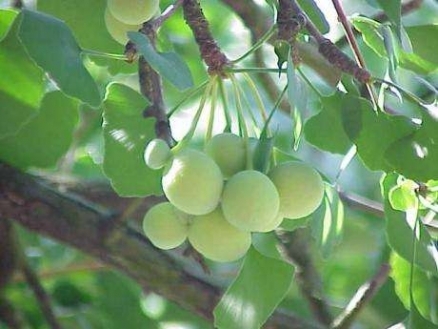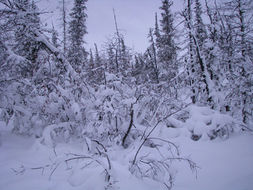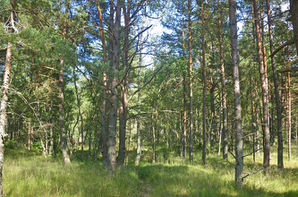Gymnosperm
A gymnosperm is one of a number of non-flowering seed bearingvegetation species, including conifers, cycads, Ginkgo and Gnetales. These species arose first in the Carboniferous Period. The wordgymnosperm derives from the Greek root gymnospermos for naked seed, meaning the exposed presentation of their ovules prior to fertilization. This naked seed condition differs from the seeds of angiosperms (flowering plants), which are enclosed during pollination. Seeds of the gymnosperm develop on the surface of scale or leaf-like appendages of cones.
Contents
Lineage
Gymnosperms first appeared in the late Carboniferous Period, although precursor characteristics of seed plants were evident in fossil progymnosperms from the late Devonian Period aproximately 380 million years before present. Within the mid-Mesozoic period, pollination of some extinct groups of gymnosperms were by extinct species of scorponflies which had a specialized proboscis for feeding on pollination drops. These scorponflies likely engaged in pollination mutualism with gymnosperms, a considerable time prior to the similar and independent co-evolution of the nectar-feeding insects which pollinate angiosperms.[1]
Taxonomy
Conifers are the most numerous extant group of gymnosperms with six to eight families, with a total of 68 genera and approximately 630 species. Conifers are generally woody shrubs or trees, and most species are evergreen. The leaves of many conifers are long, thin and needle-like, others species, including most Cupressaceae and some Podocarpaceae, have flat, triangular scale-like leaves.
[2]Agathis in Araucariaceae and Nageia in Podocarpaceae have broad, flat strap-shaped leaves. Cycads, are large crowned trees with compound leaves and stout trunks, are the next most abundant group of gymnosperms, with about 130 extant species. The other extant groups are the 75 to 80 species of Gnetales and one species of Ginkgo.
The gymnosperm Welwitschia mirabilis is the sole species within the family Welwitschiaceae, and the gymnosperm Ginkgo biloba is the sole extant species within the order Ginkgophyta.
Distribution
Conifers are dominant species in most of the boreal forests, but also are found in some temperate mountainous ecoregions. Most cycads are found in tropical and subtropical regions. The Gnetales are a group of tropical evergreen shrubs, trees and vines found at lower latitudes. Regarding the Welwitschiaceae family, the species Welwitschia mirabilis is found only in the Namib Desert in southern Africa. The order Ginkgophyta has one extant species, Ginkgo biloba, [3]which occurs in eastern China, although it is widely cultivated around the globe.[4]
Reproduction
Conifers
The full organism conifer is known as the sporophyte. The gametophyte incepts at meiosis, when microsporophylls (male cone scales) containing microsporocytes become microspores, and ovules on female cone scales develop megasporocytes that turn into megaspores. Meiosis produces a tetrad of microspores that develop into a pollen grain, which, assisted by two air-filled bladders, are carried by wind to the megagametophyte within an ovule. Meiosis results in the production of four megaspores, three of which die, leaving a single functional megaspore. Within a pollen grain lies two cells, a generative sperm cell and a tube cell. Pollination occurs with the pollen grain penetrating the micropyle of the female scale. The tube cell elongates into a pollen tube, which, after about a year reaches the egg cell. The sperm cell moves through the pollen tube to the egg, and fertilisation results with the ourcome of a diploid zygote. The subsequent embryo develops within a naked seed and temporarily suspends development for overwintering. Upon receipt of the proper hormonal and environmental cues, germination occurs and a diploid sporophyte, or entire plant, develops. When the sporophyte matures, diploid male and female cones emerge, and the cycle of alternating generations is fulfulled.Cycads
As with all seed-plants, cycads exhibit a dominant diploid sporophyte phase, which life cycle element is simply the macroscopic manifestation of the full complete plant. Cycads have no true flowers, but the seeds are bare.
All cycad apecies are dioecious - male and female structures are found on separate individual plants. The male structure is termed androstrobilus, roughly appearling like a conifer cone, but consisting of many densely packed modified leaves, termed microsporophylls. Each microsporophyll produces a significant number of pollen grains on its dorsal. Their pollen is a minute, multicellular, male haploid gametophyte phase of the life cycle; pollen is dispersed by either insects or wind to the cycad female reproductive structure.
The gynostrobilus (female cone) of cycads also looks like a large pine cone, but it has a morphology different from the androstrobilus. When a pollen grain lands on the gynostrobilus, it germinates and grows a pollen tube, a long tubular cell that extends to deep within the multicellular, female haploid gametophyte. Then a sperm cell of the pollen grain swims through the pollen tube using its whip-like tail, or flagella, and fertilizes the egg to form a zygote. The zygote eventually develops into an embryo, and then a seed. Cycad seeds are rich in starch and have a pigmented, fleshy outer layer known as the sarcotesta. The seeds are often dispersed by birds and mamals, which eat them for the nutritious sarcotesta, and later defecate the viable seed.
Cycads have flagellated sperm cells, which is considered an ancient characteristic. Other evolutionarily ancient plants, such as mosses, liverworts, and ferns, also have flagellated sperm cells. More evolutionarily recent plants, such as the flowering plants, do not have flagellated sperm cells. In fact, other than the cycads, only one species of gymnosperm, the Ginkgo biloba, has flagellated sperm cells. In other gymnosperms, the sperm is carried to the female ovule by a sperm tube.
Cycads maintain a symbiotic relationship with cyanobacteria which fix nitrogen, and receive shelter and an available carbon source. In turn cyanobacteria may produce the neurotoxin, beta-methylamino-L-alanie or BMAA, which may be found in the cycad fruit in low concentrations. Whether this toxin can accumulate to harmful concentrations is not yet clear.
Welwitschia mirabilis
After germination, the cotyledons of this relict species extend to 2.5 to 3.5 centimeters; subsequently, two persistent leaves appear. These permanent leaves are manifested opposite the cotyledons. They eventually grow to a length of two to four metres and typically become split into several strap-shaped sections. Subsequently, two cotyledon buds appear; in these, the growing tip dies, inducing elongation of the buds. Growth continues sideways, which forms the obconical growth of the stem. The species is dioecious, with distinct male and female individual plants. Transfer of pollen from the male to the female strobili is effected out by insects who are attracted by nectar produced on both male and female strobili.
Ginkgo biloba
This species is dioecious, some individual plants being male and others being female. Male plants produce tiny pollen cones with sporophylls each bearing two microsporangia spirally arranged around a central axis. Cones are not produced by female plants. Two ovules are produced at the stalk terminus, and following pollination, one or both develop into seeds. The seed is 1.5 to 2.0 centimetres in length. The outer fleshy layer of the seed is browinish yellow. Seed fertilization is via motile sperm, just as for ferns, cycads, mosses and algae. Sperm exhibit a complex layered form, a continuous belt of basal bodies comprising the base of thousands of flagellae, which evince ciliate motion. The flagellae propel the sperm body, which need merely a minute transport distance to the archegonia. While two sperm are formed, merely one of actually fertilizes the ovule.References
Citation
Hogan, C. (2014). Gymnosperm. Retrieved from http://editors.eol.org/eoearth/wiki/Gymnosperm- ↑ D.Ren, C.C.Labandeira, J.A.Santiago-Blay, A.Rasnitsyn, C.K.Shih, A.Bashkuev, M.A.Logan, C.L.Hotton and D.Dilcher. 2009. Probable Pollination Mode Before Angiosperms: Eurasian, Long-Proboscid Scorpionflies. Science, 326 (5954), 840-847
- ↑ Reece Campbell. 2005. Phylum Coniferophyta. Biology. 7th. ed.
- ↑ Thomas N.Taylor and Edith L.Taylor. 1993. The Biology and Evolution of Fossil Plants. Englewood Cliffs, NJ. Prentice Hall
- ↑ C.Michael Hogan, ed. 2010. Ginkgo biloba L.. Encyclopedia of Life/ARKive.






